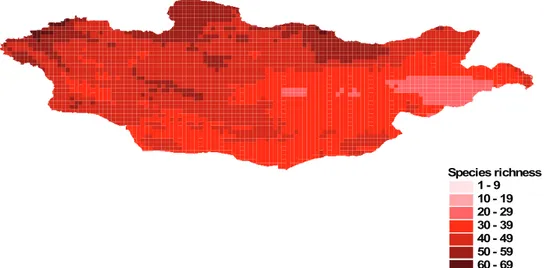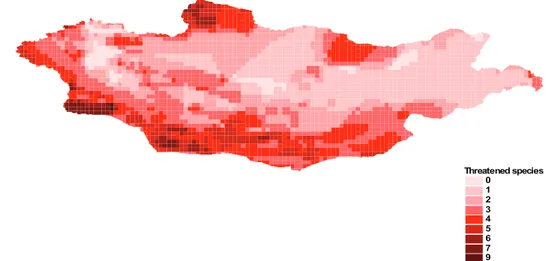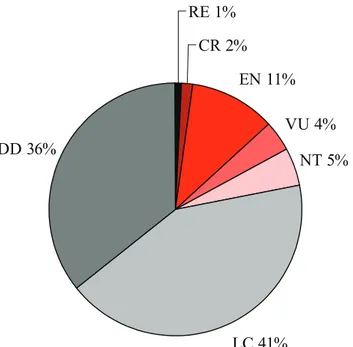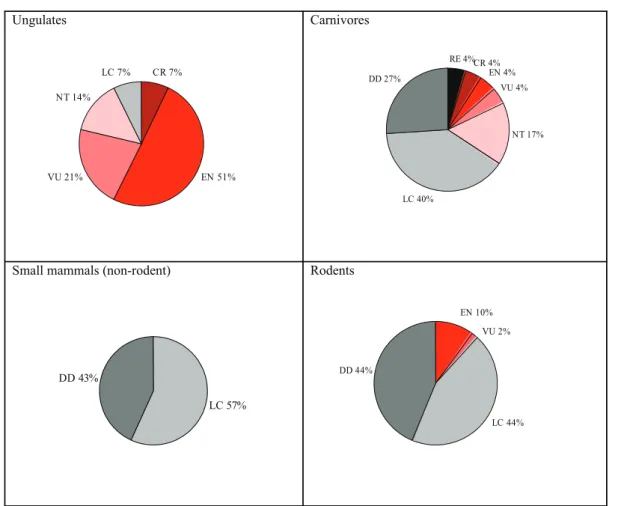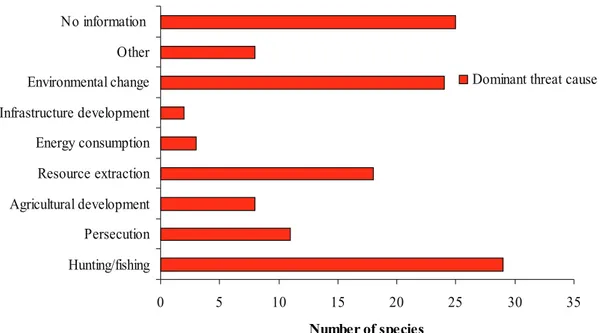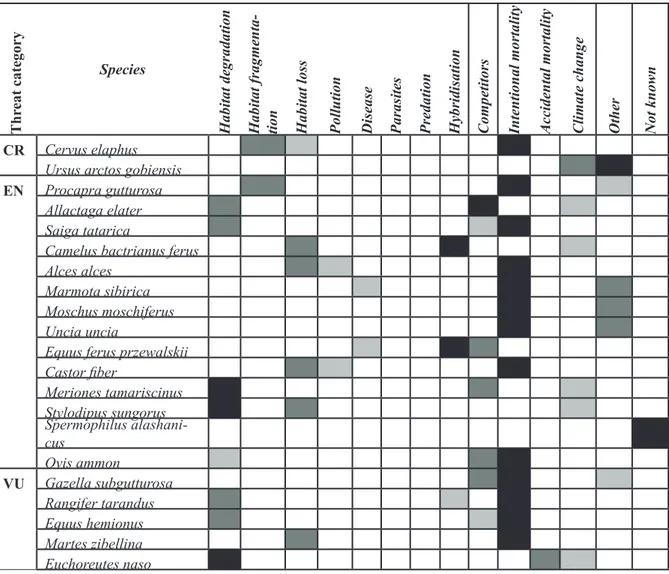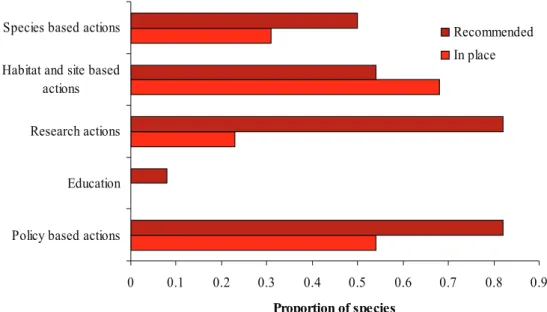17
Proceedings of the Mongolian Biodiversity Databank Workshop: Assessing
the Conservation Status of Mongolian Mammals and Fishes: II –
Mam-mals: Assessment Results and Threats.
Emma L. Clark
1, Joanne F. Ocock
1, Sarah R. B. King
2, and Jonathan E.M. Baillie
1* 1Zoological Society of London, Regents Park, London, NW1 4RY, England. 2Steppe Forward Pro-gramme, Biology Faculty, National University Mongolia, Ulaanbaatar 210646, Mongolia. E-mail: Emma.clark@zsl.org, Joanne.ocock@zsl.org, sarah.king@zsl.org, *Corresponding author: Jonathan.baillie@ioz.co.uk
Abstract
The Mongolian Biodiversity Databank Workshop was held at the National University of Mongolia and Hustai National Park from 1st October to 4th November, 2005. As part of the workshop, participants assessed the conservation status of all Mongolian mammal species using the IUCN Categories and Cri -teria. Of the 128 species assessed, 2% were Critically Endangered (CR), 11% Endangered (EN) and 4% Vulnerable (VU). A further 5% were categorised as Near Threatened (NT) and 36% categorised as Data Deicient (DD). Ungulates were the most highly impacted: 79% were threatened with extinction. Twelve percent of carnivore species and 12% of rodent species were threatened. No non-rodent small mammal species were listed in a threatened category. Rodents and non-rodent small mammals were less well known, with 44% and 43% respectively found to be Data Deicient. This may have affected the threat assessment of these species. Greatest species richness of Mongolian mammals was found in the northern and western part of the country. The greatest number of threatened species also inhabit the north of the country, as well as the south-west. The main threat affecting most mammals in Mongolia was hunting, with lack of enforcement of legislation also considered a problem.
Keywords: biodiversity, extinction risk, mammal, Mongolia, threat
Introduction
The irst Mongolian Biodiversity DatabankWorkshop, held at the National University of Mon-golia and Hustai National Park from 1st October
to 4th November, 2005, aimed to identify current
knowledge of Mongolian mammals by bringing together experts in the ield. Over several days of discussion these zoologists applied the IUCN Categories and Criteria to all mammal species and assessed threats affecting them. During this time, data were entered into the Mongolian Biodiversity Databank, including the justiications for the as -sessments. Although research has been conducted on Mongolian mammals for many years, relatively little has been published in the west and has there-fore not received the international recognition that it deserves. This workshop enabled researchers to come together and share information, with the result that data about these species, or the lack of it, could be identiied and published.
Mongolia is a large country with a small popula-tion (2.4 million people in 1.56 million km2) that
is currently undergoing a period of socio-political
wild-life, and also direct the attention of researchers and NGOs to the animals most at risk or most lacking in information.
The results of the workshop relating to mam-mals are presented in this article. The distribution of each mammal species was assessed, which enabled production of maps to explore large scale patterns within Mongolia such as areas of high species rich-ness, high numbers of threatened species, or areas where Data Deicient species are concentrated. These maps are necessarily preliminary for many species, such as the small mammals. By assess-ing each species with the IUCN Categories and Criteria, species most at risk of extinction could be identiied, as well as those needing further re -search. Finally, the participants could assess the threats most affecting Mongolian mammals, and so discuss conservation measures needed to mitigate these. It is hoped that the results presented here will be a positive step in the ongoing conservation of Mongolian mammals.
Results and Discussion
The distribution of Mongolian mammalsThe mammal distribution maps developed at the workshop were overlaid using ArcView 3.0 and are presented here to explore patterns of species rich -ness, threatened species richness and areas where there are high concentrations of poorly known taxa. The more northern provinces such as Bayan-Ul-gii, Uvs, Khövsgöl, Selenge and Khentii had the highest concentration of mammals, with recorded numbers of species exceeding 60 in the northern
part of Bayan-Ulgii and Uvs provinces (Figure 1). In contrast, species richness was lowest in eastern Mongolia.
Khovd, Khövsgöl, Gobi-Altai, Bayankhongor and Umnugobi were revealed as provinces with a high number of threatened species (Figure 2). Areas of very high species richness such as Khövsgöl and Khentii also had high richness of threatened spe-cies. However, southern areas, such as Gobi-Altai, Omnogobi and Dornogobi, although not containing high species richness, had the highest richness of threatened species. It is possible that these prov -inces support high numbers of threatened species because they were extirpated elsewhere in Mon -golia, therefore these areas may serve as refugia (Reading pers. coms.).
Species were categorised as Data Deicient (DD) where there was insuficient information to con -idently assess their risk of extinction. In general these species tended to be small mammals such as bats, rodents and insectivores, but a number of larg-er mammals wlarg-ere also categorised as DD. Many of the provinces with high species richness had a high number of DD species (e.g. Khövsgöl, Selenge and Khentii), and provinces with low species richness tended to have lower numbers of DD species (e.g. Dornod, Sukhbaatar, Tov and Dundgobi) (Figure 3). However, there were also a number of regions in southern Mongolia with relatively low species richness and disproportionately high numbers of DD species, such as Gobi-Altai, Umnugobi and Dornogobi. This possibly relects the lack of re -search conducted in these areas, particularly in the
Species richness 1 - 9 10 - 19 20 - 29 30 - 39 40 - 49 50 - 59 60 - 69
south-eastern desert zone.
The status of Mongolian mammals
Mongolian mammal species to be assessed were agreed upon by the Taxon Steering Com -mittee, resulting in a list of 128 species. As for the Red Lists, only wild populations inside their native range or populations resulting from benign introductions were included. In general, mammals were assessed at the species level. Thus distinct subspecies within Mongolia, such as Saiga tatarica monogolica, an important subspecies of the saiga antelope, is referred to as Saiga tatarica. The only taxa that are referred to at the subspecies level are the Gobi bear (Ursus arctos gobiensis), the Bactrian camel (Camelus bactrianus ferus) and Przewalski’s horse (Equus ferus przewalskii). The Gobi bear was included because the subspecies was identiied as an
Threatened species 0
1 2 3 4 5 6 7 9
Figure 2. Species richness of threatened Mongolian mammals. The darker shades represent areas with the highest number of threatened species.
extremely important taxa for Mongolian conserva -tion and was assessed at the subspecies level. The Bactrian camel is referred to as Camelus bactrianus ferus rather than Camelus bactrianus to make it clear that only the wild population is being con-sidered. Recent taxonomic evidence (Oakenfull et al., 2000) suggests that although they are geneti -cally distinct, the domestic horse and Przewalski’s horse are both subspecies of Equus ferus (Boddaert, 1785). Therefore in this article, Przewalski’s horse will be referred to as (Equus ferus przewalskii), indicating only wild horses are included in the as-sessment.
Of the 128 species assessed, 17% were catego -rised as regionally threatened, of which 2% were Critically Endangered (CR), 11% Endangered (EN) and 4% Vulnerable (VU) (Figure 4). A further 5% were categorised as Near Threatened (NT).
Thirty-Data deficient species 0
1 - 2 3 - 4 5 - 6 7 - 8 9 - 10 11 - 12 13 - 14 15
six percent of the mammals of Mongolia were cat -egorised as Data Deicient (DD). Only one species, the Asiatic wild dog (Cuon alpinus) was categorised as Regionally Extinct (RE) in Mongolia.
When Mongolian mammal species were divided into discrete groups such as ungulates and carni-vores, their overall conservation status could be compared (Figure 5). Virtually all the ungulates (Artiodactyla and Perissodactyla) were classiied as threatened in Mongolia. Eleven (79%) of the 14 ungulate species assessed were categorised as threatened and of the remaining three ungulates, two were categorised as NT. None of the ungulates were classiied as DD. Twelve percent of the carni -vores, including species such as the snow leopard (Uncia uncia), sable (Martes zibellina) and Gobi bear, were categorised as threatened. A further 17% were categorised as NT and 40% were listed as Least Concern (LC). Unlike the ungulates, a high proportion (27%) were DD.
There are many species of Rodentia in Mongo -lia, including members of the families Castoridae, Dipodidae, Muridae, Myoxidae and Sciuridae. In Mongolia, this large group is comprised of species such as the small ive-toed jerboa (Cardiocranius paradoxus),Siberian marmot (Marmota sibirica), and Eurasian beaver (Castor iber). Twelve percent of rodents were classiied as threatened, which is fewer than both ungulates and carnivores, but a high
proportion (44%) were classiied as DD, indicat -ing that rodents remain poorly understood and the actual number of threatened species may be much higher. Of all the other small (non-rodent) mam -mals, such as bats, hedgehogs, hares and shrews (Chiroptera, Erinaceomorpha, Lagomorpha and Soricomorpha) none were classiied as threatened with extinction. However, again a high number of these species were listed as DD (43%) and further research may indicate a number of these species are threatened.
Threatened species
Twenty-one taxa were categorised as threatened in Mongolia and a further six were listed as NT (Table 1). Twelve of these were also classiied as threatened or NT on a global scale (IUCN, 2004; see Table 2). Mongolia contains signiicant popu -lations of many of these globally threatened spe-cies, such as the Asiatic wild ass (E. hemionus), Przewalski’s horse, Bactrian camel, saiga antelope and snow leopard. Many of the species classiied as regionally threatened have subspecies in Mongolia endemic to Central Asia, therefore management of these populations in Mongolia has major implica-tions for the global status of the species.
RE 1%
CR 2%
EN 11%
VU 4%
NT 5%
LC 41% DD 36%
Ungulates
CR 7%
EN 51% VU 21%
NT 14% LC 7%
Carnivores
RE 4%CR 4% EN 4%
VU 4%
NT 17%
LC 40% DD 27%
Small mammals (non-rodent)
LC 57% DD 43%
Rodents
EN 10%
VU 2%
LC 44% DD 44%
Figure 5. A comparison of the conservation status of four discrete groups of Mongolian mammals. RE = Regionally Extinct, CR = Critically Endangered, EN = Endangered, VU = Vulnerable, NT = Near Threatened, LC = Least Concern and DD = Data Deicient.
Table 1. Mammals categorised as regionally threatened (Critically Endangered, Endangered and Vul -nerable) and Near Threatened in Mongolia.
Critically Endangered Endangered Vulnerable Near Threatened
Red deer
Cervus elaphus
Argali
Ovis ammon
Goitered gazelle Gzella subgutturosa
Siberian ibex
Capra sibirica Gobi bear
Ursus arctos gobiensis
Mongolian gazelle Procapra gutturosa
Reindeer
Rangifer tarandus
Wild boar Sus scrofa
Saiga antelope
Saiga tatarica
Sable
Martes zibellina
Grey wolf Canis lupus Bactrian camel
Camelus bactrianus ferus
Asiatic wild ass
Equus hemionus
Corsac fox
Vulpes corsac Moose
Alces alces
Long-eared jerboa
Euchoreutes naso
Red fox
Vulpes vulpes Siberian musk deer
Moschus moschiferus
Pallas’s cat Otocolobus manul
Snow leopard Uncia uncia
Przewalski’s horse Equus ferusprzewalskii Eurasian beaver Castor iber
Small ive-toed jerboa Allactaga elater Mongolian three-toed jerboa
Stylodipus sungorus
Tamarisk jird Meriones tamariscinus
Siberian marmot Marmota sibirica
At the workshop, the IUCN global conserva -tion assessments were reviewed and in some cases recommendations were made to change the assess-ments. Among the recommended changes was the re-classiication of Przewalski’s horse from Extinct in the Wild (EW) to EN. Przewalski’s horse was last seen in the wild in 1969 (Wakeield et al., 2002) and was oficially listed as EW by the IUCN Equid Specialist Group in 1996 (IUCN, 2004). Follow -ing re-introduction in 1992, the population is now living in the wild without human assistance. The number of mature individuals is greater than 50 and the population is reproducing successfully, which qualiies it as Endangered, using criterion D. This is a major conservation success for Mongolia. For more information see the article on Przewalski’s horse (King, 2006) in this volume.
Comparison with global data
IUCN has assessed the global conservation sta -tus of nearly ive thousand mammal species using the IUCN Red List Categories and Criteria, of which 23% were classiied as threatened with extinction, 12% NT and 8% DD (Baillie et al., 2004). Although the proportion of mammals threatened regionally within Mongolia was 17%, the actual proportion may be quite similar to the global igure when the large number of DD species (36%) have been re -searched and ascribed a status category. The high number of DD species within Mongolia indicated that this region remains relatively poorly studied.
Threats to Mongolian mammals
During the assessment process, participants identiied the main activities or processes resulting in the decline of species, such as resource extraction and hunting/ishing (Figure 6). They also identiied the direct threat causing the decline, such as loss of habitat, disease or pollution. In all cases where
identiied as the main processes leading to the de -cline of Mongolian mammals (Figure 6). These were followed by persecution and increasing livestock numbers. The large percentage of DD species was relected in the high number for which the dominant threat could not be identiied. Energy consumption and infrastructure development were identiied as much less dominant threat processes.
Where applicable, the primary, secondary and tertiary direct threats were identiied for each spe -cies. Intentional mortality caused by hunting was the primary threat identiied for more than half the threatened mammals (62%, see Table 3). This was a particularly serious threat for ungulates such as the saiga antelope, argali (Ovis ammon), red deer, Siberian musk deer (Moschus moschiferus) and Mongolian gazelle, as well as furbearers such as snow leopards and Siberian marmots. This threat has resulted in rapid declines of many species in recent years. For example, over the past decade the Siberian marmot has declined by roughly 70% in Mongolia, largely due to illegal and unsustainable
Table 2. The global threatened status of species from the 2004 IUCN Red List, which were also assessed as regionally threatened or Extinct in Mongolia at the Biodiversity Databank Workshop 2005
Critically Endangered Endangered Vulnerable Near Threatened
Saiga antelope Saiga tatarica
Asiatic wild dog Cuon alpinus
Siberian musk deer Moschus moschiferus
Pallas’s cat
Otocolobus manul
Bactrian camel
Camelus bactrianus ferus
Snow leopard Uncia uncia
Goitered gazelle
Gazella subgutturosa
Eurasian beaver Castor iber Przewalski’s horse
Equus ferus przewalskii
Argali Ovis ammon Long-eared jerboa
Euchoreutes naso
Asiatic wild ass Equus hemionus
hunting (Batbold, 2002). Mongolian argali popula -tions were believed to have experienced an even greater rate of decline, 70% in one generation, also largely driven by illegal hunting (Amgalanbaatar et al., 2002). The red deer was found to have one of the highest decline rates for all Mongolian mammals – 92% over 18 years (Zahler et al., 2004), resulting in it being assessed as Critically Endangered. This has also been primarily attributed to illegal hunting. It is noteworthy that while intentional mortality (hunting) was by far the greatest present threat to Mongolian mammals, it is not the most signiicant threat to mammals globally. On a global scale the threat of hunting is dwarfed by habitat destruction and degradation (Baillie et al., 2004). It is likely therefore, that while Mongolian mammals are un-doubtedly affected by habitat loss and degradation, the threat of hunting is having a much greater and more immediate impact.
Habitat degradation was the primary threat to three species: Tamarisk jird (Meriones tamarisci-nus), Mongolian three-toed jerboa (Stylodipus sun-gorus) and long eared jerboa (Euchoreutes naso) (Table 3). For these species, the cause of the habi -tat degradation was overgrazing due to increasing numbers of livestock. These are small mammals and therefore less threatened by hunting pressures. Together, habitat loss, fragmentation and degrada-tion were a secondary threat to more than half the threatened species. In all cases, habitat degradation
was caused by overgrazing from livestock. Two spe-cies, the red deer and the Mongolian gazelle, were secondarily threatened by habitat fragmentation, caused by infrastructure development. Habitat loss was a secondary threat to ive species, of which two are artiodactyls, the Bactrian camel and moose ( Al-ces alAl-ces), and was caused by increasing resource extraction and mining. Other causes of habitat loss, such as logging and clear-felling of forests, were found to be reducing habitat available to Eurasian beaver and sable. Competition was also an impor -tant secondary threat due to increasing numbers of livestock that overlap with the resources required by wildlife. Threats recorded as the third most in-luential were more varied, including disease and pollution of water systems from gold-mining.
Climate change was identiied as a secondary and tertiary threat to some species and highlighted as an important threat for the future. Many of the species for which climate change was identiied as a threat are distributed in the south, such as the Gobi bear and Bactrian camel, where severe conditions most commonly occur. However, as many of the species in this region were listed as Data Deicient, the impact of climate change may be poorly docu-mented. If the projections from climate models are correct (Millennium Ecosystem Assessment, 2005), then climate change will likely be the dominant threat for the future.
0 5 10 15 20 25 30 35
Hunting/fishing Persecution Agricultural development Resource extraction Energy consumption Infrastructure development Environmental change Other No information
Number of species
Dominant threat cause
Table 3. Summary of the direct threats facing threatened Mongolian mammals, as identiied by the workshop
participants. The primary threat is represented by a black square, the secondary threat is mid grey, and the terti-ary threat is light grey.
Thr
eat category
Species
Habitat degradation Habitat fragmenta
-tion Habitat loss Pollution Disease Parasites Predation Hybridisation Competitors Intentional mortality Accidental mortality Climate change Other Not known
CR Cervus elaphus
Ursus arctos gobiensis
EN Procapra gutturosa
Allactaga elater Saiga tatarica
Camelus bactrianus ferus Alces alces
Marmota sibirica Moschus moschiferus Uncia uncia
Equus ferus przewalskii Castor iber
Meriones tamariscinus Stylodipus sungorus Spermophilus alashani-cus
Ovis ammon
VU Gazella subgutturosa
Rangifer tarandus Equus hemionus Martes zibellina Euchoreutes naso
Conservation measures
For each species, conservation measures in place were identiied and further conservation measures were recommended (Figure 7). Habitat and site-based actions, such as protected areas, were iden-tiied as in place for the largest proportion of spe -cies. This was followed by policy-based actions, including legislation, and then actions relating spe-ciically to species. No education measures were acknowledged.
Participants recognised that a signiicant pro -portion of the territory of Mongolia is currently designated as protected. The establishment of The National Programme on Special Protected Areas in 1998 by the State Great Khural (Parliament), has expanded the network of protected areas and aims to have them covering 30% of Mongolia by 2030
(Jargal, 2003). A number of species have a large proportion of their distribution within protected ar-eas, e.g. the Gobi bear, saiga antelope, long-eared jerboa and snow leopard. Although there are many protected areas, it has been noted that some pro-tected areas have a size and habitat-type that is not optimal for many species, particularly migratory ungulates (Johnstad & Reading, 2003). In addition, greater resources are needed to effectively manage these parks. Therefore, participants recommended that future management and appropriate designa-tion of protected areas should have priority to better conserve biodiversity.
0 0.1 0.2 0.3 0.4 0.5 0.6 0.7 0.8 0.9 Policy based actions
Education Research actions Habitat and site based
actions Species based actions
Proportion of species
Recommended
In place
Figure 7. The proportion of species for which the different conservation measures in place and further actions recommended were identiied.
‘Very Rare’ in the Law on Fauna is prohibited en -tirely by the Law on Hunting (Wingard & Odgerel, 2001). Further, Mongolia is a signatory country to the Convention on the International Trade of En -dangered Species (CITES). The Convention regu -lates trade of endangered species by establishing export quotas to obtain sustainable trade, such as for the argali, which is listed in Appendix II and permits 80 hunting trophies with horns, and 44 skins and horns to be exported from Mongolia (UNEP-WCMW, 2006). In some cases trade is prohibited if the species is threatened, such as the snow leop-ard, listed in Appendix I (UNEP-WCMC, 2006). Policy actions were the most important conserva-tion measure identiied for the future (Figure 7), which includes the enforcement of existing laws. Currently, enforcement is considered inadequate to protect species from illegal hunting. Better enforce-ment of current laws will require better recruiting, training and provisioning of oficers, and inancial investment (Zahler et al., 2004). Once this has been achieved, more legislation protecting threatened and near threatened species is also required, for example there is no law article currently protecting the wolf (Canis lupus) (NT) or the majority of the threatened rodent species.
Research actions, in addition to policy-based actions, were recommended as highly important conservation measures for the future (Figure 7). Participants also noted that measures relating to habitat and site-based actions were still required and
that education initiatives should be implemented for some species. Educational programmes were not identiied as in place for any species. While it is true there are few educational programmes promot-ing the conservation of biodiversity, a number do exist, such as the Zoological Society of London’s Steppe Forward Programme and the Snow Leop -ard Trust, and are particularly beneicial to species threatened by illegal or unsustainable hunting, by raising awareness of the status of the species and laws protecting it. Research actions are necessary as much remains to be discovered about the tax -onomy, ecology, threats and population trends of many Mongolian mammals. This is particularly im-portant for species located in the southern regions of Mongolia, because compared with northern and western regions, many were assessed as DD. These research needs are illustrated by poorly understood species such as the Gobi bear, which is lacking in all aspects of ecology, taxonomy and population data (Zahler, 2004), and the argali, which receives little active management due to a lack of information on ecology, population dynamics, trends and behaviour (Amgalanbaatar & Reading, 2003).
its charismatic species. The rates of population de-cline mentioned in this article should not be left unchecked. As the climate of the world changes, management responses will also have to adapt. The arid environments of Mongolia are likely to be more susceptible to climate change and the future conservation of Mongolian mammals will need to involve a multi-faceted approach to ensure precious few are lost.
Acknowledgements
We are grateful to the World Bank for providing the resources for this project and would like to thank all who participated in the workshop for their time and contributions. We are also especially grateful to Michael Stubbe, David Tinnin, David Mallon and Richard Reading for their expert advice and reviews. Thanks are also given to the National University of Mongolia and the Taxon Steeering Committee for their guidance and support, in particular Prof R. Samiya, Prof. S. Dulamtseren and N. Batsaikhan. The authors would like to thank those who have reviewed this article at various stages, Ben Collen, Renata Kowalik, Chris Sandbrook and Ken Ocock. We would like to thank Wes Sechrest from the IUCN Global Mammal Assessment for providing the ini -tial mammal distribution maps. We would like to give further thanks to J. Munkhbat for his extensive involvement in the collection and veriication of the data in the article, and to Sh. Oyunchimeg for her dedication in compiling information, sourcing reviewers and logistical skills. As well, the other staff of the Steppe Forward Programme, J. Jargal and Lucy Simpson, were instrumental as workshop group leaders.
References
Amgalanbaatar, S., Reading, R.P., Dulamtsuren, S., Onon, Yo., Tumentsetseg, Sh., & Batsukh, N. 2002. Assessment of argali sheep (Ovis ammon) distribution in Mongolia using GIS. Proceed-ings of the Institute of Biology of the Mongolian Academy of Sciences (Mammalogical studies of Mongolia and its adjacent territories). 2: 26-34 (In Mongolian).
Amgalanbaatar, S. & Reading, R. 2003. Argali sheep conservation and research activities in Mongolia. Biodiversity Brieings from Northern Eurasia.Special supplement in Russian Conser-vation News. 2(1): 14-16.
Asian Development Bank (ADB). 2005. Country
Environmental Analysis: Mongolia. Asian De -velopment Bank.
Baillie, J.E.M., Hilton-Taylor, C. & Stuart, S.N. 2004. 2004 IUCN Red List of Threatened Spe-cies. A Global Species Assessment. IUCN, Gland, Switzerland.
Batbold, J. 2002. The problem of management of marmots in Mongolia. In K.B. Armaitage & V.Y. Rumiantsev (ed.): Holarctic marmots as a factor of biodiversity. Proceedings of the Third International Conference on Marmots, Cheboksary (in Russian and English).
Groves, C. P. 1986. The taxonomy, distribution and adaptations of recent equids. In R. H. Meadow & H-P Uerpmann (Eds.) Equids in the ancient world. Dr Ludwig Reichert Verlag, Wiesbaden.
IUCN. 2005. Guidelines for Using the IUCN Red List Categories and Criteria http://app.iucn.org/ webiles/doc/SSC/RedList/RedListGuidelines. pdf . Accessed on 17th February 2006.
Jargal, J. 2003. Protected area status in Mongolia. Mongolian Journal of Biological Sciences. 1(2): 49-54.
Johnstad, M. & Reading, R. 2003. Mongolia’s protected areas system. Biodiversity Brieings from Northern Eurasia. Special supplement in Russian Conservation News. 2(1): 8-11. Millenium Ecosystem Assessment. 2005.
Ecosy-stems and Human Well-being Synthesis. Island Press, Washington, D.C.
King, S. R. B. 2006. Extinct in the Wild to Endan -gered: the history of Przewalski’s horse (Equus ferus przewalskii) and its future conservation. Mongolian Journal of Biological Sciences. 3(2): in press.
Oakenfull, E. A., Lim, H. L. & Ryder, O. A. 2000. A survey of equid mitochondrial DNA: Impli -cations for the evolution, genetic diversity and conservation of Equus. Conservation Genetics. 1: 41-55.
Olson, K.A., Fuller, T.K., Schaller, G.B., Odonk -huu, D. & Murray, M.G. 2005. Estimating the population density of Mongolian gazelles Procapra gutturosa by driving long-distance transects. Oryx. 9:164-169.
Reading, R.P., Johnstad, M.D., Batjargal, Z., Am -galanbaatar, S. & Mix, H.M. 1999. Expanding Mongolia’s system of protected areas. Natural Areas Journal. 19:211-222.
org/. Accessed on 15th February 2006.
Wakeield, S., Knowles, J., Zimmermann, W. & Van Dierendonck, M. 2002. Status and action plan for the Przewalski’s horse (Equus ferus przewalskii). In P. Moehlman (ed.): Equids: Zebras, Asses and Horses. Status survey and conservation action plans. IUCN, Gland. pp. 82-92.
Wingard, J.R., & Odgerel, P. 2001. Compendium of Environmental Law and Practice in Mongolia. GTZ Nature Conservation and Buffer Zone De -velopment Project and GTZ Commercial Civil Law Reform Project. (English and Mongolian language).
Ykhanbai, H., Odgerel, Ts., Bulgan, E. & Naranchimeg, B. 2005. Herder Women Speak
Out: Towards more equitable co-management of grasslands and other natural resources in Mongolia. In R. Vernooy (ed.): Social and Gen-der Analysis in Natural Resource Management - Learning Studies and Lessons from Asia. Sage Publications, London. pp.181-206
Zahler, P. 2004. Recent management and conserva -tion initiatives for Mongolian gazelle, Mongo-lian saiga antelope and Gobi bear. Mongolian Journal of Biological Sciences. 2(2): 47-49. Zahler, P., Lhagvasuren, B., Reading, R., Wingard,
